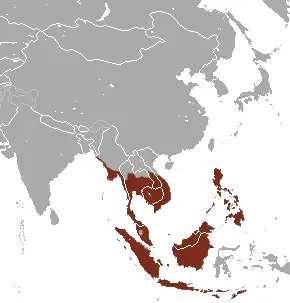Long-tailed macaques
Appearance
The unique exhibits an extremely long tail, which is longer than its height from the head to the rump. This primate has a pinkish-brown face and white spaces on its eyelids, near the nose. Another conspicuous characteristic of this species is the crest on the head top, formed by the hairs on the head, sweeping back over the forehead. Male Long-tailed macaques are distinguished by moustaches as well as cheek whiskers around their faces. Females, on the other hand, have beards and cheek whiskers.
| POPULATION SIZE | UNKNOWN |
| LIFE SPAN | 15-30 YRS |
| WEIGHT | 3-9 KG |
| LENGTH | 38-55 CM |
The crab-eating macaque (Macaca fascicularis ), also known as the long-tailed macaque and referred to as the cynomolgus monkey in laboratories, is a cercopithecine primate native to Southeast Asia. A species of macaque, the crab-eating macaque has a long history alongside humans. The species has been alternately seen as an agricultural pest, a sacred animal, and, more recently, the subject of medical experiments.
The crab-eating macaque lives in matrilineal social groups of up to eight individuals dominated by females. Male members leave the group when they reach puberty. It is an opportunistic omnivore and has been documented using tools to obtain food in Thailand and Myanmar. The crab-eating macaque is a known invasive species and a threat to biodiversity in several locations, including Hong Kong and western New Guinea. The significant overlap in macaque and human living space has resulted in greater habitat loss, synanthropic living, and inter- and intraspecies conflicts over resources.
| KINGDOM | Animalia |
| PHYLUM | Chordata |
| CLASS | Mammalia |
| SUBPHYLUM | Vertebrata |
| ORDER | Primates |
| SUBORDER | Haplorhini |
| INFRAORDER | Simiiformes |
| FAMILY | Cercopithecidae |
| GENUS | Macaca |
| SPECIES | Macaca fascicularis |
The Long-tailed macaques are found throughout south-eastern Asia. Their range extends from the southeastern tip of Bangladesh southwards to Malaysia and the Maritime Southeast Asia islands (including Sumatra, Java and Borneo), offshore islands, the Philippines as well as the Nicobar Islands in the Bay of Bengal. The ideal habitat for this species is disturbed areas and forest periphery. However, these primates occur in different habitats from primary lowland rainforests and disturbed, secondary rainforests to shrubland, riverine and coastal forests of nipa palm, mangroves and even human settlements.
Distribution Long-tailed macaques
| CONTINENTS | Asia, Africa, Oceania |
| SUBCONTINENTS | South Asia, Southeast Asia, Sub-Saharan Africa |
| COUNTRIES | Bangladesh, Brunei, Cambodia, India, Indonesia, Laos, Malaysia, Myanmar, Philippines, Singapore, Thailand, Timor-Leste, Viet Nam Mauritius, Palau, Papua New Guinea |
| INTRODUCED COUNTRIES | Indomalayan |
| BIOGEOGRAPHICAL REALMS | Mangrove, Tropical dry forest, Tropical moist forests |
| BIOMES |
Habits and Lifestyle
These primates are diurnal and highly social creatures, forming groups of 1 or more males as well as 3 – 20 females with their young. As a general rule, the majority of mature individuals of a group are females. Males usually disperse upon reaching maturity to form new groups or join bachelor herds. Males live in a well-defined linear hierarchy system, where individuals are ranked depending on age, size, and fighting skills. Young females, on the other hand, remain with their natal group, forming the core of the group. Related females typically live in close relationships. Overall, females of this species commonly practice mutual grooming, where lower-ranking individuals groom higher-ranking ones, due to which the former avoid intimidation, and get support during conflicts as well as access to limited resources of the group.
Diet and Nutrition
As omnivorous animals, Long-tailed macaques consume food of both plant and animal origin. They eat fruits, crabs, flowers, leaves, fungi, grasses and clay, supplementing this diet with various insects.

Mating Habits
| MATING BEHAVIOR | Polygyny, Polygynandry |
| REPRODUCTION SEASON | most births occur in May-July |
| PREGNANCY DURATION | 162 days |
| BABY CARRYING | 1 infant |
| INDEPENDENT AGE | 420 days |
| FEMALE NAME | Male |
| MALE NAME | male |
| BABY NAME | infant |
Long-tailed macaques exhibit polygynous (one male mate with multiple females) and polygynandrous (promiscuous) (multiple males mate indiscriminately with multiple females) mating systems. Most births occur in May-July, during the rainy season. The gestation period lasts for 162 days, after which high-ranking females usually give birth to a single infant at an interval of 390 days, while others produce offspring every 2 years. The newborn baby is nursed until 420 days old. The age of reproductive maturity is 6 years old in males and 4 years old in females.
Population
Population threats
Threats to the population of this species vary, depending on geographical location. For example, Long-tailed macaques in the Philippines are hunted for food and sport. On the other hand, those in the mainland areas (including Cambodia and Vietnam) are commonly captured by humans: while females are taken for breeding, males are used in laboratory research. In certain parts of their range, these animals are considered pests and hence persecuted. In other areas, they face the loss of their natural habitat. However, these primates are highly adaptable by nature and are capable of living in a wide range of environments.
Population number
The exact number of Long-tailed macaques total population is currently unknown. However, as reported on the IUCN Red List, specific populations have been estimated in the following areas: eponymous sub-species on the Nicobar Islands – around 4,800 individuals; eponymous sub-species on Con Son – less than 1,000 animals; Bangladesh – under 100 individuals. Further, as reported by the Cities resource, the population in Malaysia is around 742,000 individuals, including 258,000 macaques around urban areas such as Kuala Lumpur. The population of Long-tailed macaques is presently decreasing, although the animals are listed as Least Concern (LC) on the IUCN Red List.


